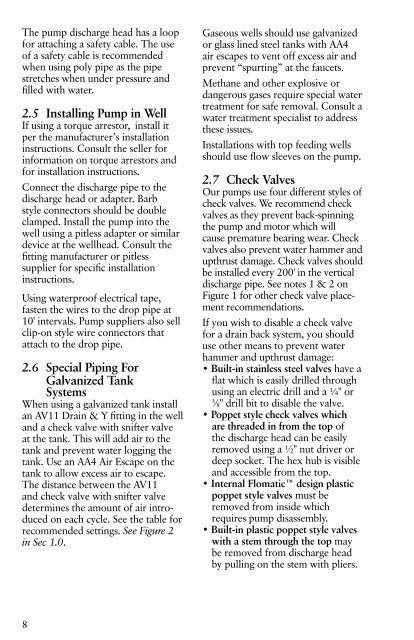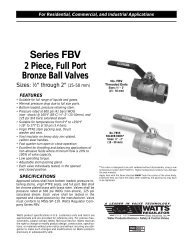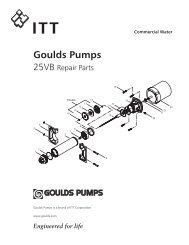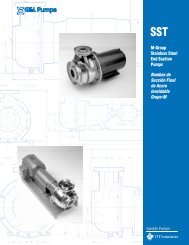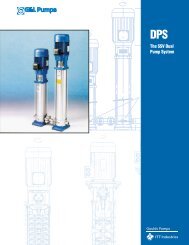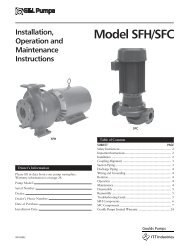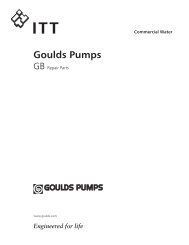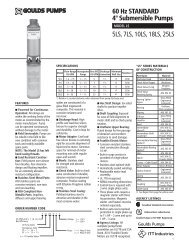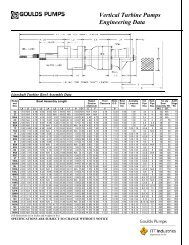5-18SB Installation & Operation Manual
5-18SB Installation & Operation Manual
5-18SB Installation & Operation Manual
Create successful ePaper yourself
Turn your PDF publications into a flip-book with our unique Google optimized e-Paper software.
The pump discharge head has a loop<br />
for attaching a safety cable. The use<br />
of a safety cable is recommended<br />
when using poly pipe as the pipe<br />
stretches when under pressure and<br />
filled with water.<br />
2.5 Installing Pump in Well<br />
If using a torque arrestor, install it<br />
per the manufacturer’s installation<br />
instructions. Consult the seller for<br />
information on torque arrestors and<br />
for installation instructions.<br />
Connect the discharge pipe to the<br />
discharge head or adapter. Barb<br />
style connectors should be double<br />
clamped. Install the pump into the<br />
well using a pitless adapter or similar<br />
device at the wellhead. Consult the<br />
fitting manufacturer or pitless<br />
supplier for specific installation<br />
instructions.<br />
Using waterproof electrical tape,<br />
fasten the wires to the drop pipe at<br />
10' intervals. Pump suppliers also sell<br />
clip-on style wire connectors that<br />
attach to the drop pipe.<br />
2.6 Special Piping For<br />
Galvanized Tank<br />
Systems<br />
When using a galvanized tank install<br />
an AV11 Drain & Y fitting in the well<br />
and a check valve with snifter valve<br />
at the tank. This will add air to the<br />
tank and prevent water logging the<br />
tank. Use an AA4 Air Escape on the<br />
tank to allow excess air to escape.<br />
The distance between the AV11<br />
and check valve with snifter valve<br />
determines the amount of air introduced<br />
on each cycle. See the table for<br />
recommended settings. See Figure 2<br />
in Sec 1.0.<br />
8<br />
Gaseous wells should use galvanized<br />
or glass lined steel tanks with AA4<br />
air escapes to vent off excess air and<br />
prevent “spurting” at the faucets.<br />
Methane and other explosive or<br />
dangerous gases require special water<br />
treatment for safe removal. Consult a<br />
water treatment specialist to address<br />
these issues.<br />
<strong>Installation</strong>s with top feeding wells<br />
should use flow sleeves on the pump.<br />
2.7 Check Valves<br />
Our pumps use four different styles of<br />
check valves. We recommend check<br />
valves as they prevent back-spinning<br />
the pump and motor which will<br />
cause premature bearing wear. Check<br />
valves also prevent water hammer and<br />
upthrust damage. Check valves should<br />
be installed every 200' in the vertical<br />
discharge pipe. See notes 1 & 2 on<br />
Figure 1 for other check valve placement<br />
recommendations.<br />
If you wish to disable a check valve<br />
for a drain back system, you should<br />
use other means to prevent water<br />
hammer and upthrust damage:<br />
• Built-in stainless steel valves have a<br />
flat which is easily drilled through<br />
using an electric drill and a ¼" or<br />
3 ⁄8" drill bit to disable the valve.<br />
• Poppet style check valves which<br />
are threaded in from the top of<br />
the discharge head can be easily<br />
removed using a ½" nut driver or<br />
deep socket. The hex hub is visible<br />
and accessible from the top.<br />
• Internal Flomatic design plastic<br />
poppet style valves must be<br />
removed from inside which<br />
requires pump disassembly.<br />
• Built-in plastic poppet style valves<br />
with a stem through the top may<br />
be removed from discharge head<br />
by pulling on the stem with pliers.


